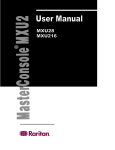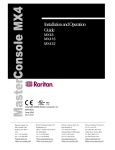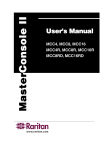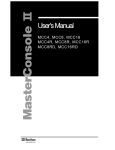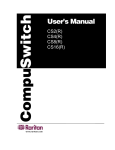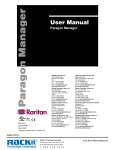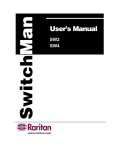Download Raritan AUATC User manual
Transcript
Installation and Operation Manual AUATC Supported by: ® Technology Corporation Rackit ® Technology Corporation 274 Madison Avenue, New York, NY 10016 Tel: (212) 679-0050 • Fax: (212) 679-0040 1 . 8 0 0 . 6 3 6 . 3 4 3 4 www.RackitTechnology.com This page intentionally left blank. Installation and Operation Manual AUATC C UL US 1F61 I.T.E. LISTED Copyright ©2003 Raritan Computer, Inc. ATC-0B-E October 2003 255-33-0001 Raritan Computer Inc. Raritan Computer Europe, B.V. Raritan Computer Japan, Inc. Raritan Computer Taiwan, Inc 400 Cottontail Lane Eglantierbaan 16 Kuga Building 7F 5F, 121, Lane 235, Somerset, NJ 08873 2908 LV Capelle aan den IJssel 11-6, Kuramae 4-chome Pao-Chiao Rd., Hsin Tien USA The Netherlands Taitoo-ku, Tokyo 111-0051, Japan Taipei Hsien, Taiwan, ROC Tel. 1-732-764-8886 Tel. 31-10-284-4040 Tel. 81-3-5833-6360 Tel. 886-2-8919-1333 Fax. 1-732-764-8887 Fax. 31-10-284-4049 Fax. 81-3-5833-6336 Fax. 886-2-8919-1338 [email protected] [email protected] [email protected] [email protected] http://www.raritan.com http://www.raritan.com http://www.raritan.co.jp http://www.raritan.com.tw This page intentionally left blank. FCC Information This equipment has been tested and found to comply with the limits for a Class A digital device, pursuant to Part 15 of the FCC Rules. These limits are designed to provide reasonable protection against harmful interference in a commercial installation. This equipment generates, uses, and can radiate radio frequency energy and if not installed and used in accordance with the instructions, may cause harmful interference to radio communications. Operation of this equipment in a residential environment may cause harmful interference. Trademark Information Product names mentioned in this document are trademarks or registered trademarks of their respective companies. Raritan, Paragon, MasterConsole, and their respective logos are trademarks or registered trademarks of Raritan Computer, Inc. PS/2, RS/6000, and PC/AT are registered trademarks of International Business Machines Corporation. Sun is a registered trademark of Sun Microsystems. Microsoft and Windows are registered trademarks of Microsoft Corporation. All other marks are the property of their respective owners. Japanese Notification This page intentionally left blank. TABLE OF CONTENTS i Table of Contents CHAPTER 1: INTRODUCTION ...........................................................................1 AUATC Overview ....................................................................................................................1 Product Photos........................................................................................................................1 Product Features.....................................................................................................................1 Package Contents ...................................................................................................................1 CHAPTER 2: INSTALLATION ............................................................................3 AUATC Configuration Diagrams..............................................................................................4 CHAPTER 3: OPERATING AN ASCII DEVICE WITH THE AUATC TERMINAL CONVERTER .................................................................................................7 Screen Layout .........................................................................................................................7 Online Mode ............................................................................................................................8 Buffer Edit Mode......................................................................................................................9 Set-Up Operations.................................................................................................................10 APPENDIX A: FAQ ......................................................................................11 ii TABLE OF FIGURES Table of Figures Figure 1 PS/2 Keyboard/Monitor Terminal ....................................................................................................4 Figure 2 AUATC with a KVM Switch .............................................................................................................4 Figure 3 AUATC with a SMX Sun KVM switch..............................................................................................5 Figure 4 On Line Session ..............................................................................................................................8 Figure 5 AUATC Help Screen .......................................................................................................................9 Figure 6 Buffer Edit Screen ...........................................................................................................................9 Figure 7 Set Up Communication .................................................................................................................10 Figure 8 Set Up Programmable Keys..........................................................................................................10 CHAPTER 1: INTRODUCTION 1 Chapter 1: Introduction AUATC Overview Congratulations on your purchase of Raritan’s AUATC terminal converter! The AUATC is designed to emulate an “ASCII terminal,” converting RS232 serial ASCII terminal data to PS/2 keyboard and VGA video or Sun keyboard and Sun video. This conversion allows any devices that can be accessed by an ASCII terminal to be operated using a PC or Sun console. These devices can now be accessed up to 650 feet away and through Raritan’s KVM switches. Product Photos Product Features The AUATC is designed with the following unique features: • Maintains eight pages of data in a circular buffer • Incorporates a Raritan Cat5 Reach transmitter port that enables access up to 650 feet away using a Category 5 UTP Receiver (UKVMG) • Buffer Edit Mode – edit, copy (mark), and re-send to computer functions • On-Line Mode – operate ASCII device as if attached to a text terminal • 12 programmable keys for frequently performed character string commands • Use PS/2 console – PS/2 keyboard and VGA monitor – or Sun Console – Sun keyboard and composite sync Sun monitor (AUATC auto sensing) • Use with a Raritan KVM switch for convenient access to multiple ASCII devices and LAN/WAN components Package Contents (1) AUATC unit (1) DB25 MF cord (1) A10D2-06MP power adapter (1) User Manual CD-ROM 2 AUATC USER MANUAL CHAPTER 2: INSTALLATION 3 Chapter 2: Installation Follow these steps to install the AUATC. 1. Boot your ASCII device, if necessary, and configure a serial port to: VT100, 9600-baud rate, no parity, 8-bit data, 1 stop bit. 2. Using the DB25 (M/F) null modem cable included, connect the ASCII device serial port to the DB25 connector on the AUATC. AUATC DB25 Pin 2 TxD Pin 3 RxD Pin 7 GND YOUR DEVICE RxD TxD GND 3. Plug the 6VDC power supply into the AUATC. 4. Plug a PS/2 keyboard into the miniDin-6 connector and a VGA monitor to the HD15 connector on the AUATC. OR Plug a Sun keyboard into the miniDin-8 connector and a composite sync Sun monitor into the HD15 connector on the AUATC. You may need to adapt the HD15 to 13W3 with a 1396C adapter that converts HD15(M) to 13W3(F). Notes: → If the AUATC is being used with a Raritan KVM switch, connect the CCPnnU cable from the KVM switch to the AUATC keyboard, monitor, and mouse ports. Select the channel where the AUATC is connected to access the ASCII device via the KVM switch. → A DB25 (M/F) null model cable is included to connect the AUATC to your ASCII device. Please refer to the table above for pin-out details 5. A login prompt will appear on your monitor. Important! After initial installation, if switching keyboards on the AUATC unit, you must first power OFF the AUATC unit, switch keyboards, and then power ON the AUATC unit. 4 AUATC USER MANUAL AUATC Configuration Diagrams Figure 1 PS/2 Keyboard/Monitor Terminal Figure 2 AUATC with a KVM Switch CHAPTER 2: INSTALLATION 5 Figure 3 AUATC with a SMX Sun KVM switch Remote Access up to 650’ Away The AUATC has a Raritan Cat5 transmitter port (RJ45) that enables you to operate a keyboard and monitor up to 650’ away using standard Category 5 Enhanced UTP cable. A Raritan Cat5 Receiver, model URKVMG, is required. Follow the installation procedure provided with the URKVMG for complete installation instructions. 6 AUATC USER MANUAL CHAPTER 3: OPERATING AN ASCII DEVICE WITH THE AUATC TERMINAL CONVERTER 7 Chapter 3: Operating an ASCII Device with the AUATC Terminal Converter This section describes how to access and operate an ACSII-based device with a PS/2 or Sun console (keyboard and monitor) using the AUATC. Screen Layout The AUATC produces eight color, 800x600-resolution video, which can accommodate 32 lines of 80 text characters. A typical ASCII terminal uses 24 lines, so the AUATC uses the 8 extra lines to provide system status and help information. These 8 lines are located on the top four and the bottom four lines of the screen (see Figure 4). • Line 1, top window: AUATC firmware version is displayed to the right • Line 3, top window: Cursor position and buffer page number is displayed to the left; terminal type and baud rate are displayed to the right • Line 4, top window: Communication status is displayed at the center. Status can be one of the following: • − On Line: Communicating with computer. The terminal screen area displays the interactions with computer. − Help: Press <Alt-F1> to display the AUATC Help screen. − Set Up: Press <Alt-F2> or <Alt-F3> to enter set-up mode. − Buffer Edit: Press <Alt-F4> to enter buffer review/edit mode. Line 4, top window: AUATC Access indicator is displayed on the right. It indicates one of the following: • − LOC: Local port is active, either PS/2 keyboard or Sun keyboard − RMT: Remote port (RJ45) is active − NO: No port is active. The 4 lines in bottom window display command keys specific to the current screen. 8 AUATC USER MANUAL Online Mode When the AUATC is operated in On-line mode (see Figure 4), the screen area displays your interactions with the ASCII device. This mode of operation is similar to using an ASCII terminal to access and operate an ASCII device. Simultaneously, the output data stream from the device is stored in an eight-page circular buffer. This feature enables you to access and operate an ASCII device and review the historical data stream on demand. The buffer is a circular eight-page buffer, therefore it will retain the most recent eight pages of the data from the device. You can program any of the 12 function keys to contain your most often use data stream commands as described in the Set Up Operations section of this chapter. Pressing any of these keys when in on-line mode will send that data stream command to the device. This convenient feature is ideal for frequently repeated commands. During the on-line session, you can enter the following keys to control the communication with the ASCII device or access the AUATC help and set up screens: Figure 4 On Line Session • <Ctrl-Break>: Reset the serial communication with the computer and reset AUATC • <Ctrl-S>: Stop computer from sending any data; all output data will be queued in the computer • <Ctrl-Q>: Resume computer to send data • <Alt-F1>: Display Help Menu Screen (see Figure 5) • <Alt-F2>: Setup serial Communication • <Alt-F3>: Set Up Programmable Keys • <Alt-F4>: Review/Edit Buffer CHAPTER 3: OPERATING AN ASCII DEVICE WITH THE AUATC TERMINAL CONVERTER 9 Buffer Edit Mode The AUATC stores the most recent eight pages of data from the ASCII device in a circular buffer. You can edit the data in the buffer. To operate the AUATC in Edit Buffer Mode, press the <Alt-F4>. The AUATC will switch from On-Line Mode to the Buffer Edit Mode (Figure 6). Now you can view the contents of the buffer using <Page Up>, <Page Down>, <Home>, <End>, and the arrow keys to position the viewing cursor. Figure 5 AUATC Help Screen Figure 6 Buffer Edit Screen 10 AUATC USER MANUAL Set-Up Operations Press <Alt-F2> to set up the serial communication parameters and the selection of video output (see Figure 7). You can change the serial communication baud rate and transmission format to meet your device needs. You can also choose to use a VGA monitor in conjunction with a Sun keyboard, which typically requires a Sun composite sync monitor. To select a VGA video output with a Sun keyboard, first you should use a PS/2 keyboard and a VGA monitor to access AUATC. Press <Alt-A2> to get into set up screen and change the video option for Sun keyboard to VGA. Then power OFF the AUATC, replace the PS/2 keyboard with a Sun keyboard, and power ON the AUATC unit. Figure 7 Set Up Communication Press <Alt-F3> to program the 12 function keys (see Figure 8). Programmable keys allow you to store frequentlyused data streams or commands, and send them to the devices during on-line mode simply by pressing a preprogrammed function key. Figure 8 Set Up Programmable Keys APPENDIX A: FAQ 11 Appendix A: FAQ PROBLEM I do not get a device prompt (a) (b) (c) (d) (e) SUGGESTED SOLUTION Check all connectors and make sure the 6V DC power supply is connected securely. If you have the AUATC screen displayed with top and bottom help windows, make sure the status indicates “On Line”. If not press <Esc> to return to On-line status. Make sure you have configured the device serial port to match what is being displayed on the serial communication set up screen. Press <Alt-F2> to show the screen. Make sure you are using a RS232 null-modem cable. Make sure your device is powered ON. No video display, or video is scrambled (a) Make sure your monitor can handle a video resolution of 800x600 with 60 Hz refresh rate. (b) If you are using Sun keyboard, by default the HD15 video port will generate composite sync signal for Sun monitor. You may need a 1397 adapter (HD15 to 13W3) to connect a Sun monitor to the HD15 video port on the AUATC. Or you can go to the set up screen (press <Alt-F2>) to change video output to be VGA video with a Sun keyboard and use a VGA monitor. Keyboard connected to AUATC does not work If you have changed keyboards, you may not have powered OFF the AUATC before doing so. Power off the AUATC, reconnect the keyboard, and power ON the AUATC. 12 255-33-0001 AUATC USER MANUAL





















